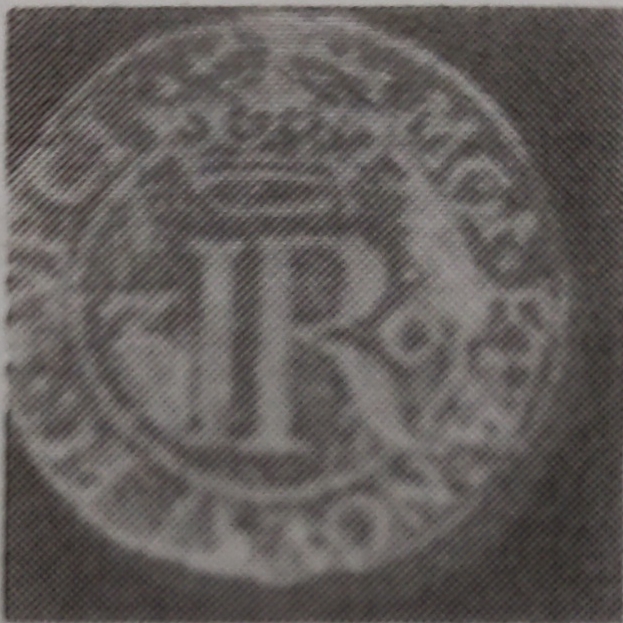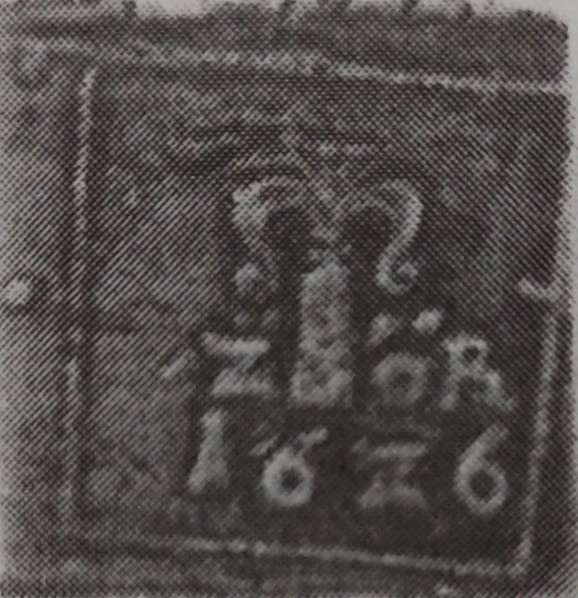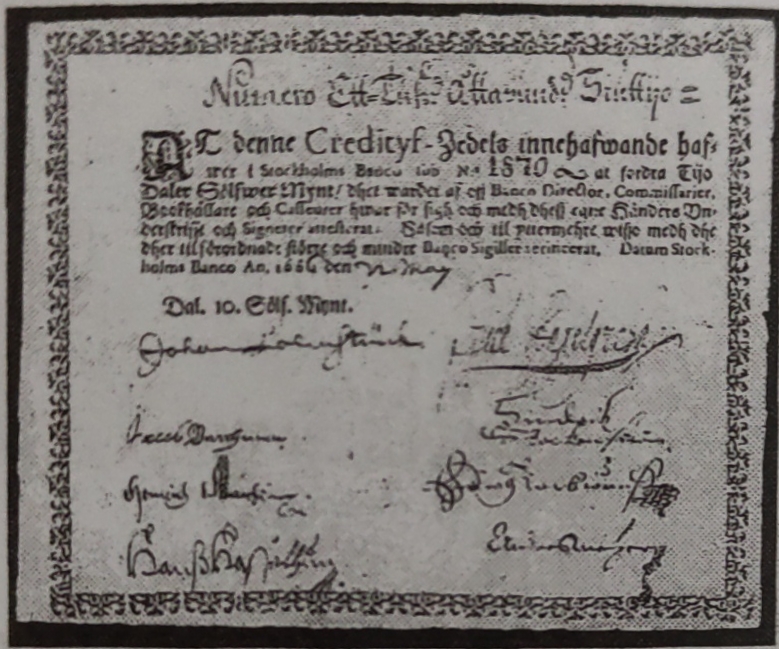UNIQUE SWEDISH PLATE MONEY Gerald Clewley
The discovery by divers of Swedish copper plate money, used as ballast in two ship wrecks. prompted further investigation as to the origin of this unusual currency. It came from the hold of a sailing ship the "Nicobar" that sank off the coast of Africa during a storm in the 178O's and the "Grev Ernst Schimmelmann" which sank off Cape Verde Islands in I78I and was salvaged in 1999. Other examples of copper plate money are to be found in the National Maritime Museum, London, which came from an unidentified wreck of a merchantman (1780--1850) that sank in the Edinburgh Channel in the Thames Estuary.
Sweden in the 17th Century was not at peace with her neighbours at that time and she had one of the largest armies in Europe, with continual conflicts with Russia. Denmark, Poland and Germany in the "30 year War' (1618-1648). The import of goods and material from abroad to support the armed forces proved to be a heavy burden on the country's economy, as these trade transactions had to be paid in silver. This resulted in the silver reserves quickly disappearing overseas and in tum caused even greater financial crisis. Having very few silver mines of her own Sweden did possess the largest copper mines in the world and a way had to be found to pay off these excessive debts. Copper coinage seemed to be the solution. This article looks at the run up to the use of copper as a currency.
In the late 16th century, in the reign of Johan III (1537-1592), there was a severe shortage of silver bullion. The mines were running short of silver ore and toward the end of his reign it was found necessary to introduce copper into the silver coinage and this in turn caused inflation to soar out of control. Johan's son, Sigismund. King of Poland, succeeded to the Swedish throne in 1592. A catholic, he was later deposed by Charles IX (1550-1611) a protestant, who was elected king in 1604. He also was involved in a number of unsuccessful wars with Denmark. Russia and Poland and Charles's continued disputes with his neighbours was sending the inflation to an all time high, believed to be about 800 per cent. It is this period that saw large amounts of copper added to the silver coins in an attempt to produce more coins from this precious metal. but this proved to be an economic disaster.
In 1554 the first Daler coins were struck, later to be replaced by the riksdaler. The daler was not minted after 1604 only the riksdaler (minted daler).
Silver Copper Coin

When Charles IX died the protestant Gustave Adolphus (1592-1632) assumed the throne in 1611 at the age of 16 years. In 1620 a two-tier monetary standard was established which was to be based on copper because of the shortage of silver. A decision was made by the king in 1624 to introduce the first true copper coin. It was small and rectangular in shape with the intrinsic value of the silver coinage. Considerable efforts were being made to create a Swedish copper monopoly. The Swedes also controlled the best copper mines, but now the military debts and the adding of more copper to the already inflated currency resulted in the silver coins deflating even further. Eventually the king was killed at the Battle of Lutzen (November 1632) leaving the woes of the country to the new ruler.
Copper coin of 1626

Christina (1626-1689) daughter of Gustavus, then ascended the throne at the tender age of 6 and in 1644 at the age of 18 was crowned Queen. 1644 saw for the first time the introduction of parallel copper coinage in the form of "Swedish Plate Money" from the mint in Avesta. This enormous, unwieldy and cumbersome l0 daler copper coin weighed in at a staggering 19.7kg (441b) and was rectangular in shape and it measured 14" x20" x0.5". These were exchanged later for exchequer issued bills called assignats which circulated as money. The problem with this early paper was that it was easy to forge and the paper money soon lost credibility. The Queen was unable to resolve the economic crisis and abdicated in 1654. Being a catholic in a predominantly protestant country she decided to pack her bags and hot- footed it down to Rome with all her belongings and never returned.
Plate money circa 1644. 20x14x0.5cm l9.7kg.

The largest coin in the world King Karl X Gustav (1622-1660) was declared the new king in 1654 and a short time later married Hedvik Eleonora. Charles was suffering from serious financial problems, but being so preoccupied with the warfare against Denmark and Poland he took very little interest in the affairs of state. To defeat his enemies he wanted to make one final push and in his endeavours to raise more money for his campaigns died of a stroke on February 13th 1660.
King Charles XI (1655-1697) was only 4 when made king of Sweden and reigned from 1660 until his death. During his reign, in 1668, a private bank was taken over by the state . becoming the Riksbank the first national bank in the world, The Riksdag of the Estates. or Ståndsriksdagen, when they were assembled, the institution was the highest authority in the realm apart from the monarchy. Johan Palmstruch (1611-1671) was a Dutch merchant who started his bank. the "Stockholm Banco", in 1657. He became a commissioner in the National Board of Trade after this and in 1661 Stockholm Banco issued Europe's first national paper money Kreditivsedlar (credit paper) and was a great success. This was an attempt to replace the absurd overvalued copper currency. There was paper money around before this that took the form of cashier notes. or transport notes, but these were not actually bank notes.
Palmstruch had serious omissions in his bookkeeping which culminated in his arrest in 1639. charged for bad accounting, the result of issuing far too many bank notes in the form of unsecured loans. He was unable to make up the shortfall and in 1668 was sentenced to lose his life. The government reprieved the death penalty and Palmstruch was instead imprisoned; where he remained until 1670. He died the following year at the age of 60. On 16th May 1668 The Bank of the Estates of the Realm, The Sveriges Riksbank, was founded becoming the first national bank in the world.
The first bank note Circa 1661

1676 saw the 10 daler Swedish copper plate (issued in 1644) withdrawn from circulation. Nevertheless copper plate coins of smaller denominations were being produced the 8, 4, 2 and 1 daler. The 8 daler weighed in at 17kg and in 1674 the 3 and 5 were minted. There was no limit put on the amount of plate in circulation. Undoubtedly, the 10 daler copper coin turned out to be the largest coin in the world (an example can now be viewed in the Department of Numismatics at the British Museum). By the 1670s the 10 daler copper coin ceased to be manufactured.
British Merchant Consul in Sweden, Patrick Lyall, smuggled some 1800 daler copper plate coins out of Sweden in 1669 and his relative James Lyall shipped 300 pieces of copper money to London in 1678.
King Charles XII (1682-1718) was the King of Sweden from 1697 to 1718. The Kings of this period did love wars, this time with Peter I of Russia, Saxony, Denmark-Norway and Poland. During his absence of 15 years, known as the Great Northern Wars (1700-1720), emergency coins were issued between 1716 and 1719. Every copper plate coin had to be represent a given value of a silver coin, with a weight of 756 grams. The government did not guarantee the value of the new coins which was to be redeemed by the holder at the end of the war. In 1718 the Government did redeem the coins, but only by 50. Georg Heinrich Von Gortz took up the post as Chief Minister to sort out the mess in 1714 and he minted a new copper currency validated with the kings head. This token money helped to finance the king's wars by depreciating the Swedish currency. After the king's untimely death in battle at the age of 36, Ulrika Eleonara (1688-1741) became Queen regnate of Sweden from 1718 to 1720 and then Queen consort until her death leaving no heirs to the throne. The new queen had Gortz beheaded in 1719 as traitor for his past acts, partly for running imaginary money and partly because the token money was much detested by the population.
King Frederick I of Sweden (1676-1751) reigned 1720 to 1751. By 1745 the reliance on bank notes or paper money caused the decline of the use of plate money (Platmynt) although a large number of daler plates were exported as bullion due to the depreciation of the plate money from 1715-1719.
Adolf Frederick (1710-1771) reigned from 1751 to 1771. He was known in Sweden as the king who ate himself to death.
Gustav III (1746-17920 reigned from 1771-1792. By 1771 the copper plate ceased to be considered as money. Reform took place in 1776 and the copper currency was abolished and silver became the main currency. Most of the plates remaining in the country were exported in 1778 when there were high copper prices in the world market. Mr Woods. a collector of coins in the 1880's, recorded the weights of his coinage as ½ daler 1742, 13oz; 1 daler 1710, 22oz; 2 daler 1710, 76 ½ oz; 4 daler 1736, 104oz. Another collector recorded an 8 daler of 1640 at 15 kilos.
References.
1. The Gentleman's Magazine, 1880, Swedish Coinage by Mr Urban
2. Avesta Myntmuseum, Avesta, Sweden
3. Network North by Steven Murdock 2005
4. British Museum
5. National Maritime Museum, Greenwich
Today we only have credit coins, as neither bank notes nor coins have any net worth corresponding to the bullion value which they represent.

